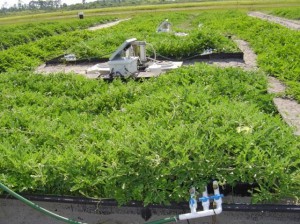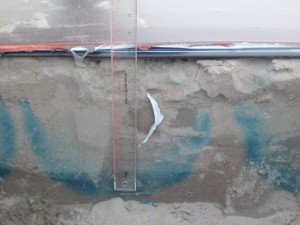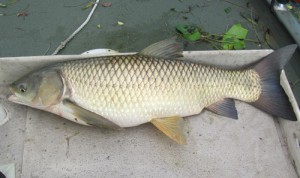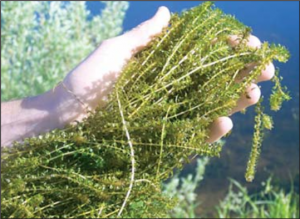
EDIS is the University of Florida’s Official website with fact sheets available to download on a wide variety of topics for free.
The University of Florida IFAS Extension offers a database of fact sheets available for free download on the Internet called EDIS (Electronic Data Information Source) that has many publications of interest to farmers and ranchers in Northwest Florida. Each fact sheet has a PDF or printer friendly link in the top left corner. The following are just a few of the new fact sheets that were recently added to the collection pertaining to commercial agriculture production. http://edis.ifas.ufl.edu
Drip Irrigation
 Water Use for Drip-Irrigated Watermelon with Plastic Mulch in Florida
Water Use for Drip-Irrigated Watermelon with Plastic Mulch in Florida
Watermelon is an important crop in Florida and accounts for a significant part of its agricultural water use. Watermelon is grown in open fields and on raised plastic-mulched beds, with the latter being the predominant production system in Florida. Accurate water use estimates for this crop are needed to develop better water allocation and management plans as well as for irrigation management. This publication summarizes the results from a crop water-use study for the drip-irrigated watermelon in south Florida. This 3-page fact sheet was written by Sanjay Shukla, Niroj K. Shrestha, Thomas A. Obreza, and Brian J. Boman, and published by the UF Department of Agricultural and Biological Engineering, August 2014.
http://edis.ifas.ufl.edu/ae508
Using Multi-Sensor Soil Moisture Probes to Decide When and How Long to Run Drip Irrigation
Several methods of irrigation scheduling are used by producers, including the feel method, calendar method, soil water balance method, and soil moisture measurement method. The latter two methods are superior and help avoid too much or too little irrigation, because they consider the water storage within the plant root zone. The soil moisture method commonly involves measuring soil moisture in the root zone and irrigating when the soil moisture falls below 33% or 50% depletion of available water capacity (water in soil that is available to the plant). This 6-page fact sheet was written by Sanjay Shukla and Nathan Holt, and published by the UF Department of Agricultural and Biological Engineering, July 2014.
http://edis.ifas.ufl.edu/ae505
 Interpreting Dye Test Results for Improved Drip Irrigation Management for the Mulched Vegetable-Production Systems in South Florida
Interpreting Dye Test Results for Improved Drip Irrigation Management for the Mulched Vegetable-Production Systems in South Florida
With Florida’s water withdrawals expected to increase by 30% from 2000 to 2030, South Florida vegetable producers are conserving water by converting traditional seepage irrigation systems to drip irrigation, which can have up to 90% efficiency when used effectively. Dye tests can provide important information for implementing a proper drip irrigation management program. This 6-page fact sheet was written by Sanjay Shukla, Nathan Holt, and Gregory Hendricks, and published by the UF Department of Agricultural and Biological Engineering, July 2014.
http://edis.ifas.ufl.edu/ae506
Pond Weeds
A Beginner’s Guide to Water Management: Aquatic Plants in Florida Lakes
This circular represents a summary of current knowledge on aquatic plants and aquatic plant management strategies, highlighting the Florida situation. The major focus of this circular is the management of aquatic plants as opposed to dealing with nutrients, algae, or water clarity. Included are sections on aquatic plant biology, aquatic plant management problems, and aquatic plant management techniques. This 43-page guide was written by Florida LAKEWATCH; reviewed by Mark Hoyer, and published by the UF Department of Fisheries and Aquatic Sciences, June 2014.
http://edis.ifas.ufl.edu/fa163
 Grass Carp, the White Amur: Ctenopharyngodon idella Cuvier and Valenciennes (Actinopterygii: Cyprinidae: Squaliobarbinae)
Grass Carp, the White Amur: Ctenopharyngodon idella Cuvier and Valenciennes (Actinopterygii: Cyprinidae: Squaliobarbinae)
The grass carp, Ctenopharyngodon idella Cuvier and Valenciennes, was imported to the U.S. in 1963 as a biological control agent for hydrilla (Hydrilla verticilliata (L.f.) Royle) and other aquatic plants. Concerns of escape and reproduction, and the potential impacts that colonization of the fish could have on native flora and fauna led to research that developed a non-reproductive fish, which was equally effective in controlling hydrilla. In the warm waters of Florida, with abundant food, grass carp grow quickly at around 2 lbs/month or 0.91 kg/month and may achieve weights of 97 lbs (44 kg). Younger fish and female fish grow faster than older or male fish. Grass carp are the most effective biological control tool that has been identified for hydrilla. This 7-page fact sheet was written by Emma N.I. Weeks and Jeffrey E. Hill, and published by the UF Department of Entomology and Nematology, June 2014.
http://edis.ifas.ufl.edu/in1038
 Hydrilla Integrated Management
Hydrilla Integrated Management
The focus of the book is on hydrilla management in Florida, although the described tactics are known and used in many of the 28 states in the United States with hydrilla infestations. Divided in seven chapters, the book guides the reader through a general introduction to the problems associated with hydrilla; identification of the plant; instructions for early detection of infestations including federal and state laws and regulations; detailed descriptions of available control tactics; proposals for integrated management plans; descriptions of insects and fish associated with hydrilla; and supplementary information including contacts for assistance when readers encounter infestations. This 144-page book was written by Jennifer L. Gillett-Kaufman, Verena-Ulrike Lietze, and Emma N.I. Weeks, and published by the UF Department of Entomology and Nematology, August 2014.
http://edis.ifas.ufl.edu/in1044
- Northwest Florida Beef Cattle Conference & Trade Show – February 11 - December 19, 2025
- Friday Feature:The Sears Catalog –How Rural America Shopped before the Internet - December 19, 2025
- November 2025 Weather Summary & Winter Outlook - December 5, 2025
